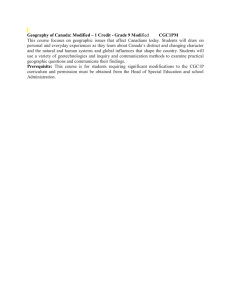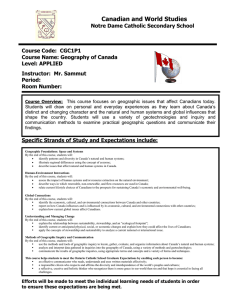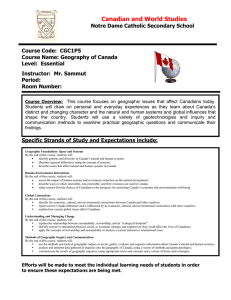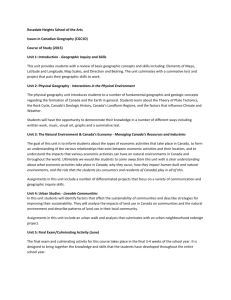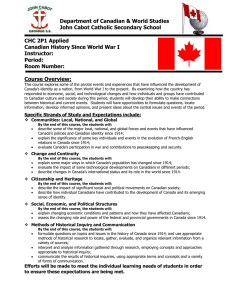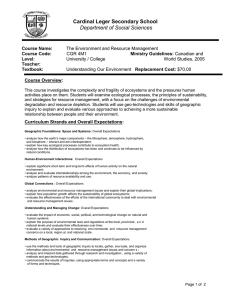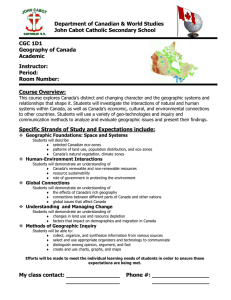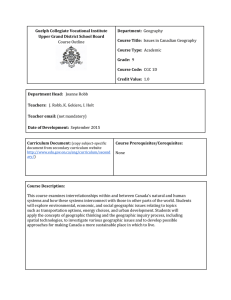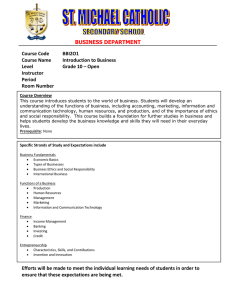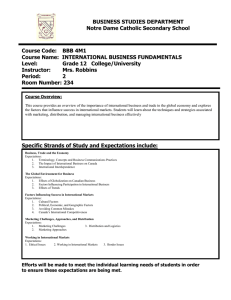Department of Canadian & World Studies John Cabot Catholic Secondary School
advertisement
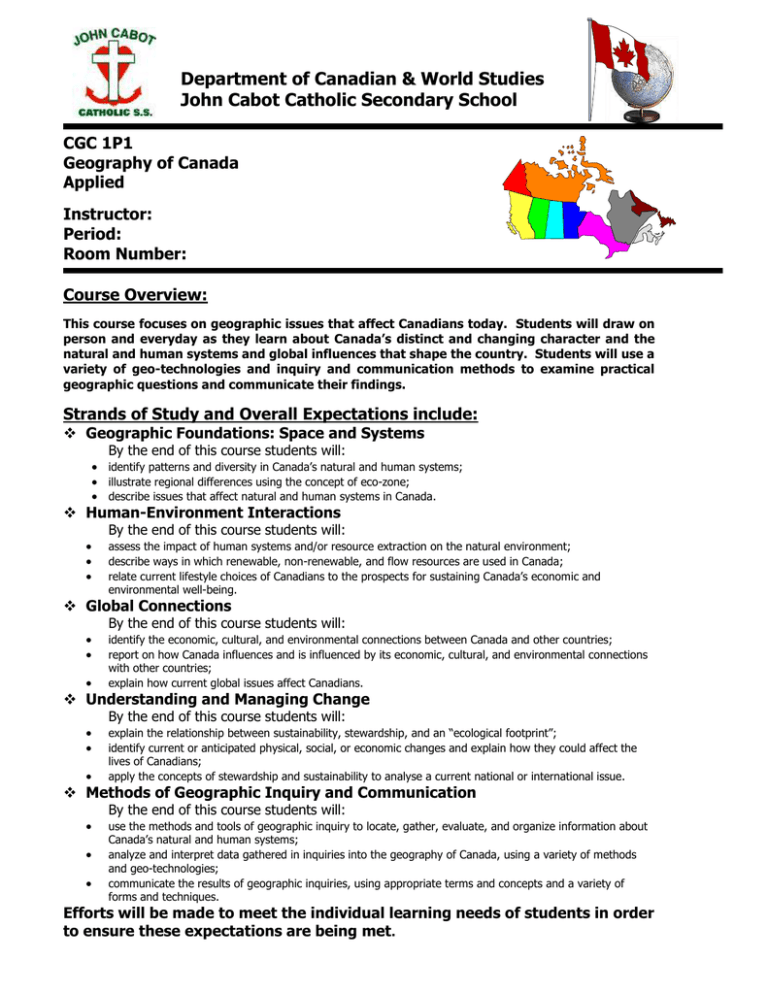
Department of Canadian & World Studies John Cabot Catholic Secondary School CGC 1P1 Geography of Canada Applied Instructor: Period: Room Number: Course Overview: This course focuses on geographic issues that affect Canadians today. Students will draw on person and everyday as they learn about Canada’s distinct and changing character and the natural and human systems and global influences that shape the country. Students will use a variety of geo-technologies and inquiry and communication methods to examine practical geographic questions and communicate their findings. Strands of Study and Overall Expectations include: Geographic Foundations: Space and Systems By the end of this course students will: identify patterns and diversity in Canada’s natural and human systems; illustrate regional differences using the concept of eco-zone; describe issues that affect natural and human systems in Canada. Human-Environment Interactions By the end of this course students will: assess the impact of human systems and/or resource extraction on the natural environment; describe ways in which renewable, non-renewable, and flow resources are used in Canada; relate current lifestyle choices of Canadians to the prospects for sustaining Canada’s economic and environmental well-being. Global Connections By the end of this course students will: identify the economic, cultural, and environmental connections between Canada and other countries; report on how Canada influences and is influenced by its economic, cultural, and environmental connections with other countries; explain how current global issues affect Canadians. Understanding and Managing Change By the end of this course students will: explain the relationship between sustainability, stewardship, and an “ecological footprint”; identify current or anticipated physical, social, or economic changes and explain how they could affect the lives of Canadians; apply the concepts of stewardship and sustainability to analyse a current national or international issue. Methods of Geographic Inquiry and Communication By the end of this course students will: use the methods and tools of geographic inquiry to locate, gather, evaluate, and organize information about Canada’s natural and human systems; analyze and interpret data gathered in inquiries into the geography of Canada, using a variety of methods and geo-technologies; communicate the results of geographic inquiries, using appropriate terms and concepts and a variety of forms and techniques. Efforts will be made to meet the individual learning needs of students in order to ensure these expectations are being met. Course Breakdown Resources: The course will use a variety of resources including geotechnology, video, CD-ROM, Internet Applications and a variety of print sources. The textbook entitled Experience Canada which will be distributed to students during the first week of the course. The text and all other resources assigned to students are the responsibility of the student. Any damage incurred will result in payment for replacement. The replacement cost for the text is $85.00. Unit One: Methods of Geographic Inquiry Constructing Maps Geographic Skills Unit Two: Canada’s Natural Diversity Landforms Climate Vegetation Unit Three: Canada’s Resource Stewardship Fishing, Farming, Forestry, Energy Managing the Resources Evaluation Structure:: Unit Four: Canada’s Economic Diversity Canada’s Trade Relations Industry and Manufacturing Involvement in World Organizations Current Global Issues Affecting Canadians Unit Five: Global Connections Unit Six: Canada’s People Demography Immigration/Cultural Diversity Knowledge/Understanding Thinking/Inquiry Communication Application 25% 20% 25% 30% The above is reflected both in the term work (worth 70% of the final mark) and the summative work (worth 30% of the final mark). Summative work consists of the Final Exam (15%) and a Culminating Activity (15%). Assessment and Evaluation Policy Students will be assessed & evaluated according to the work produced & skills displayed. Methods of providing feedback will include assessing work in process & evaluating completed assignments, tests, co-operative learning activities, simulations and presentations. Peer & self-assessments will also be utilized. Student marks will be determined by evaluating product according to 4 categories & 4 levels. Please see the chart below for specific skills and key words used to determine student competency in the different categories. Level 1: Level 2: Level 3: Level 4: Level 50-59% 60-69% 70-79% 80-100% Category Knowledge/Understanding demonstrates/ expresses knowledge and skills with limited effectiveness Knowledge of content Understanding of content Thinking Critical/creative thinking skills Planning Skills Processing Skills demonstrates/ expresses knowledge and skills with some effectiveness Communication demonstrates/ expresses knowledge and skills with considerable effectiveness demonstrates /expresses knowledge and skills with thorough effectiveness Expression and organization of ideas and information (oral, written & visual) Communication for different audiences/purposes Use of conventions of form, vocabulary & terminology Application Application of knowledge/skills in familiar contexts Transfer of knowledge/skills to new contexts Making connections within and between various contexts Feedback will also be provided for student learning skills. Skills like working independently, team work, organization, work habits and homework, and initiative are assessed independently student achievement and will be conducted through the use of a rubric indicating specific criteria to be achieved to receive each of the following letter grades: E –Excellent Other Evaluation Issues G – Good S – Satisfactory N - Needs Improvement LATE ASSIGNMENTS. Assignments submitted after the Primary Due Date established by the teacher will be accepted with a penalty of 5% off for the first day late and 2% for subsequent days to a maximum of 10%. This four day Penalty Zone is the maximum time allowed for submissions. The fourth day after the assignment is due is considered the Closure Date upon which no further assignments will be accepted. If the teacher returns the marked assignments within the four day penalty zone, the date of return is considered the closure date. Repeated lateness in submissions indicates poor organization skills and will result in parental contact and will be reflected in the learning skills section of the report card. INCOMPLETE ASSSIGNMENTS Assignments will be graded according to the extent with which they meet the criteria established MISSED TESTS A test that is missed for a legitimate reason will be written within a few days of the student returning from the absence. Student eligibility to write the test and the date of writing will be at the discretion of the teacher in consultation with the department head. CULMINATING ACTIVITIES These activities will be due toward the end of the course. They are valued between 5 and 15 per cent of the final mark and will reflect course material and competencies not otherwise emphasized on the final exam. PLAGARISM in any form reflects academic dishonesty and may result in a mark of zero for the assignment in question
